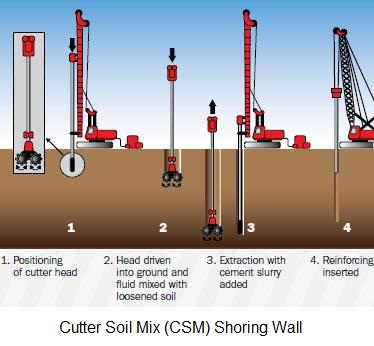Cutter Soil Mix (CSM) technology is a soil mixing technique which injects and mixes binding agents (generally cement) with the aid of water and air with in-situ soils to produce a final hardened product. Once cured, these mixed soils are capable of retaining soils and water for deep excavations, environmental cut-off walls or carrying structural loads from roads, embankments, tanks or other movement sensitive structures.
The CSM system is ideally suited to granular soils but can also be constructed through clays and some lower quality rock.
The CSM technique differs from traditional soil mixing methods by utilising cutter wheels mounted on a drive head which rotate about the horizontal axis, similar to those used on diaphragm walling mills. The use of rotating wheels on the cutter head plus full computer instrumentation and built in inclinometers ensures that CSM walls can be constructed to accurate vertical tolerances.
As a retention solution, CSM walls are cost effective as they provide a more efficient structural section than many conventional piled walls. Reducing cross sectional area means reduced wastage and cost. A significant reduction in the number of joints between panels also means that the propensity to leak through cold joints is reduced for CSM walls over traditional secant pile walls.
CSM walls can be constructed to considerable depths in either 550mm or 1000mm thickness with panels being typically 2,200mm long. Walls are reinforced by installing UC or UB sections into the freshly cast panels at spacings to suit structural loadings. As a foundation solution for movement sensitive structures such as roads, tanks and embankments CSM is ideally suited due to the large surface area of the barrette (550mm or 1,000mm wide by 2,400mm long) which provides significant shaft friction capacity, combined with the large cross sectional area of the head and lower stiffness of the material which significantly reduces punching issues into upper structures.

References: www.vibropile.com.au